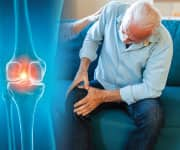Life Extension Magazine®
Glucosamine has been used for decades to rebuild cartilage in aging joints.
An analysis published in May 2019 found that regular glucosamine use was associated with a 22% lower risk of cardiovascular death.1
In seeking to ascertain the anti-death mechanisms, the autophagy-boosting property of glucosamine is a candidate, along with its inflammation-reducing effects.
Aging cells accumulate metabolic waste products that shorten healthy lifespans. In youth, cells are cleansed of this toxic debris via a natural process called autophagy.
The ability of glucosamine to “turn back on” beneficial autophagy may explain its life-extending properties.
Another beneficial mechanism is glucosamine’s ability to turn down inflammatory reactions that underlie cardiovascular disorders.
Many readers of Life Extension® magazine have supplemented with the 1,500 mg/day dose of glucosamine shown to confer these death-defying benefits.
This article describes the scientific evidence supporting the use of glucosamine to maintain healthy joint structure and function.
It also reviews new data showing reduced death rates in those who use glucosamine.
Osteoarthritis becomes more common as we age.
One reason is that the structural cartilage in joints degrades, resulting in pain, swelling, and loss of motion.
To cope, people often turn to pain relievers that do nothing to repair or restore damaged joint cartilage.
Glucosamine has been shown to relieve joint pain as effectively as drugs like ibuprofen—without harmful side effects.2
Reduced Risk for Heart Disease

Although glucosamine is traditionally used to treat osteoarthritis, studies have shown that it has a wide range of benefits.
One of the most significant findings is that regular glucosamine use is associated with a reduction in cardiovascular disease.
A 2019 study used data from 466,039 individuals without a history of cardiovascular disease.1 These subjects were followed for an average of seven years.
Compared to non-users, people who used glucosamine supplements had a 15% lower risk of total cardiovascular disease events, defined as cardiovascular death, coronary heart disease, and stroke.
When these outcomes were examined individually, glucosamine use was associated with a 22% lower risk of cardiovascular death, an 18% lower risk of coronary heart disease and a 9% lower risk of stroke.
Activating Autophagy
Studies of glucosamine in the last several years explain how it may improve health and extend lifespan.
One of the most prominent discoveries is that glucosamine induces autophagy, or “cellular housekeeping.”
Autophagy is the natural process by which cells rid themselves of toxic internal metabolic waste.
With advancing age, autophagy doesn’t always work as intended. Deficits in autophagy have been implicated in loss of function and risk for chronic disease.3
Studies in various cell types have found that glucosamine is a potent activator of autophagy.4-9 Several of these studies demonstrate that it accomplishes this by inhibiting mTOR signaling in cells. At least one study has found that it induces autophagy through an mTOR-independent pathway.9 This means that glucosamine activates autophagy by more than one mechanism!
The implications for this finding are profound. We can already see evidence that glucosamine use leads to lower rates of cardiovascular disease, cardiovascular-related death, and death by all causes in humans. The augmentation of healthy autophagy is one explanation for this remarkable finding.
Joint Deterioration

Two of the most vital components of our joints are cartilage and synovial fluid.
Cartilage covers the surface of the bone, reducing friction at the joint during movement. Synovial fluid lubricates the joint.
Over 32 million Americans are affected by osteoarthritis and it is one of the most common causes of disability.10
Osteoarthritis is more than just a wear-and-tear process; it is an inflammatory process.
Several factors play a role in the development of osteoarthritis, including:10
- Altered biomechanical properties of joint tissue,
- Increased proinflammatory mediators (i.e. cytokines), and
- Destruction of joint tissue via protein- destroying enzymes (i.e. matrix metalloproteinases).
What you need to know
Glucosamine
- In osteoarthritis many structural changes occur, including deterioration of cartilage, leading to joint pain, swelling, and loss of mobility.
- Glucosamine supports healthy cartilage and joint function.
- Clinical studies show that taking glucosamine eases joint pain about as well as pain medications.
- In addition, regular use of glucosamine has been associated with a 22% lower risk of cardiovascular death.
How Glucosamine Helps
The body uses glucosamine to synthesize cartilage and synovial fluid.11-13
It plays a crucial role in maintaining joint lubrication and has shown anti-inflammatory effects in laboratory studies.14-16
Orally administered glucosamine, in doses of 1,500 mg a day, is easily absorbed into the bloodstream and leads to direct increases of glucosamine levels at the joints.17
Decades of clinical trials have demonstrated just how well oral glucosamine works.
The Risks of NSAIDs

Faced with arthritis pain, most people turn to over-the-counter or prescription pain relievers known as non-steroidal anti-inflammatory drugs (NSAIDs), which include aspirin, ibuprofen, naproxen sodium, and celecoxib.
But these medications come with serious potential health risks, including ulcers, high blood pressure, and kidney damage.19
One study that assessed these risks found that using drugs for the treatment of osteoarthritis was associated with a greater mortality risk than surgical treatment of osteoarthritis. This study specifically found that:19
- Mortality risk was highest with naproxen (commonly sold as Aleve®),
- Gastrointestinal complications were highest with the prescription NSAID diclofenac,
- Kidney problems were highest with ibuprofen (Advil®, Motrin®), and
- Cardiovascular risk was highest with celecoxib (a prescription NSAID sold under the brand name Celebrex®).
Glucosamine, on the other hand, has a long history of human studies showing safety even when taken daily for years.
In one randomized, double-blind study of patients with knee osteoarthritis, scientists compared 1,500 mg a day of glucosamine to 1,200 mg a day of ibuprofen for two weeks. The study concluded that glucosamine is as effective as ibuprofen in treating symptoms, but without harsh side effects.2
Another recent analysis found that glucosamine was clearly superior to a placebo in relieving symptoms of knee osteoarthritis.18
Summary

Osteoarthritis becomes more common with age.
Its destructive effects on joints result in painful movement, swelling, loss of motion, and stiffness in knees, hips, hands, and other body parts.
Medications can relieve pain but come with potential side effects and don’t address the underlying damage.
Clinical trials show that oral intake of glucosamine sulfate supports healthy cartilage and joint function.
An analysis published in 2019 revealed that regular use of glucosamine was associated with a 22% reduced risk of cardiovascular death.
Glucosamine standalone capsules and multi-nutrient joint health formulas containing high-potency glucosamine are affordable and widely available.
If you have any questions on the scientific content of this article, please call a Life Extension® Wellness Specialist at 1-866-864-3027.
Glucosamine and Longevity
Although glucosamine supplementation is most widely appreciated for its impact on joint and cartilage health, recent research suggests that it also has a remarkable impact on whole-body health.
It has long been recognized that a diet that restricts calories activates several pro-longevity pathways in cells and extends life. Some nutrients modulate these same pathways.
In animal models, glucosamine has been found to be just such a compound. In a study of both roundworms and aged mice, glucosamine supplementation was found to prolong the lifespan of these experimental animals.20 Furthermore, a study of various pro-longevity nutrients and drugs found that glucosamine was one of the few that had ample evidence of life extension in multiple animal models while having one of the lowest potentials for side effects with regular use.21
Caloric restriction is one of the best documented means to extend lifespan.22 In cell and animal models ranging from yeast to mammals, either restricting total calorie intake or introducing periods of intermittent fasting is the best-known method to slow the aging process and increase longevity.
However, caloric restriction in humans can be very difficult to implement and maintain.
In an attempt to find life extending alternatives that are easier to adhere to, scientists have investigated the mechanisms by which caloric restriction protects health. They have revealed several key pathways within cells that are modified by a reduced caloric intake.
There is an ongoing search to identify so-called caloric restriction mimetics—nutrients that can impact the same pathways as caloric restriction. Recent research has revealed that glucosamine is such a compound.
Several of the cellular pathways affected by calorie restriction have been shown to be similarly affected by glucosamine supplementation:
- AMPK activation with induction of fat metabolism and mitochondrial activation5,8,23
- Activation of sirtuins24
- Induction of autophagy—cellular “housekeeping” and repair4,20
All of this has been shown to translate into life extension in animal models. In a study coming out of Switzerland, glucosamine supplementation extended the life of both worms and aged mice.20
Given this newfound property of glucosamine, scientists recently published the results of a study to further investigate glucosamine’s anti-aging abilities. In a rat model of accelerated aging, the researchers supplemented some rats with glucosamine and compared them to rats without supplementation.25
They looked at several well-established markers of aging, including markers of antioxidant capacity and glycation. In typical aging, antioxidant capacity declines and tissue damage due to glycation is increased.
In the aged animals given glucosamine, antioxidant capacity was increased, cellular antioxidant enzyme activity was increased, and glycation was reduced.
References
- Ma H, Li X, Sun D, et al. Association of habitual glucosamine use with risk of cardiovascular disease: prospective study in UK Biobank. BMJ. 2019 May 14;365:l1628.
- Qiu GX, Gao SN, Giacovelli G, et al. Efficacy and safety of glucosamine sulfate versus ibuprofen in patients with knee osteoarthritis. Arzneimittelforschung. 1998 May;48(5):469-74.
- Martinez-Lopez N, Athonvarangkul D, Singh R. Autophagy and aging. Adv Exp Med Biol. 2015;847:73-87.
- Carames B, Kiosses WB, Akasaki Y, et al. Glucosamine activates autophagy in vitro and in vivo. Arthritis Rheum. 2013 Jul;65(7): 1843-52.
- Chen CL, Chen YH, Liang CM, et al. Glucosamine-Induced Autophagy through AMPK(-)mTOR Pathway Attenuates Lipofuscin-Like Autofluorescence in Human Retinal Pigment Epithelial Cells In Vitro. Int J Mol Sci. 2018 May 9;19(5).
- Jiang L, Jin Y, Wang H, et al. Glucosamine protects nucleus pulposus cells and induces autophagy via the mTOR-dependent pathway. J Orthop Res. 2014 Nov;32(11):1532-42.
- Lv C, Wang L, Zhu X, et al. Glucosamine promotes osteoblast proliferation by modulating autophagy via the mammalian target of rapamycin pathway. Biomed Pharmacother. 2018 Mar;99:271-7.
- Shintani H, Shintani T, Ashida H, et al. Calorie Restriction Mimetics: Upstream-Type Compounds for Modulating Glucose Metabolism. Nutrients. 2018 Nov 22;10(12).
- Shintani T, Yamazaki F, Katoh T, et al. Glucosamine induces autophagy via an mTOR-independent pathway. Biochem Biophys Res Commun. 2010 Jan 22;391(4):1775-9.
- Available at: https://www.uptodate.com/contents/pathogenesis-of-osteoarthritis. Accessed January 12, 2021.
- Available at: https://www.sciencedirect.com/topics/pharmacology-toxicology-and-pharmaceutical-science/glucosamine. Accessed January 8, 2020.
- Papich MG. Glucosamine Chondroitin Sulfate. In: Papich MG, ed. Saunders Handbook of Veterinary Drugs. St. Louis: W.B. Saunders; 2016:357-8.
- Rehman S, Nabi B, Baboota S, et al. Natural anti-inflammatory agents for the management of osteoarthritis. In: Brahmachari G, ed. Discovery and Development of Anti-Inflammatory Agents from Natural Products: Elsevier; 2019:101-40.
- Aghazadeh-Habashi A, Jamali F. The glucosamine controversy; a pharmacokinetic issue. J Pharm Pharm Sci. 2011;14(2):264-73.
- Sanders M, Grundmann O. The use of glucosamine, devil’s claw (Harpagophytum procumbens), and acupuncture as complementary and alternative treatments for osteoarthritis. Altern Med Rev. 2011 Sep;16(3):228-38.
- Reginster JY, Neuprez A, Lecart MP, et al. Role of glucosamine in the treatment for osteoarthritis. Rheumatol Int. 2012 Oct;32(10):2959-67.
- Persiani S, Rotini R, Trisolino G, et al. Synovial and plasma glucosamine concentrations in osteoarthritic patients following oral crystalline glucosamine sulphate at therapeutic dose. Osteoarthritis Cartilage. 2007 Jul;15(7):764-72.
- Ogata T, Ideno Y, Akai M, et al. Effects of glucosamine in patients with osteoarthritis of the knee: a systematic review and meta-analysis. Clin Rheumatol. 2018 Sep;37(9):2479-87.
- Aweid O, Haider Z, Saed A, et al. Treatment modalities for hip and knee osteoarthritis: A systematic review of safety. J Orthop Surg (Hong Kong). 2018 May-Aug;26(3):2309499018808669.
- Weimer S, Priebs J, Kuhlow D, et al. D-Glucosamine supplementation extends life span of nematodes and of ageing mice. Nat Commun. 2014 Apr 8;5:3563.
- Janssens GE, Houtkooper RH. Identification of longevity compounds with minimized probabilities of side effects. Biogerontology. 2020 Dec;21(6):709-19.
- Lopez-Lluch G, Navas P. Calorie restriction as an intervention in ageing. J Physiol. 2016 Apr 15;594(8):2043-60.
- Kong CS, Kim JA, Kim SK. Anti-obesity effect of sulfated glucosamine by AMPK signal pathway in 3T3-L1 adipocytes. Food Chem Toxicol. 2009 Oct;47(10):2401-6.
- Igarashi M, Sakamoto K, Nagaoka I. Effect of glucosamine on expression of type II collagen, matrix metalloproteinase and sirtuin genes in a human chondrocyte cell line. Int J Mol Med. 2017 Feb;39(2):472-8.
- Kumar R, Saraswat K, Rizvi SI. Glucosamine displays a potent caloric restriction mimetic effect in senescent rats by activating mitohormesis Rejuvenation Res. 2021 Jan 21.

